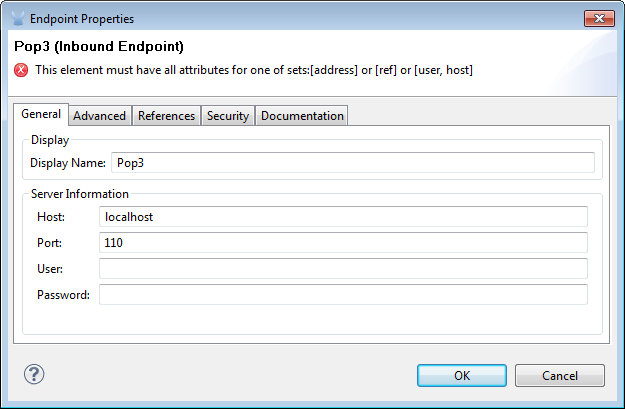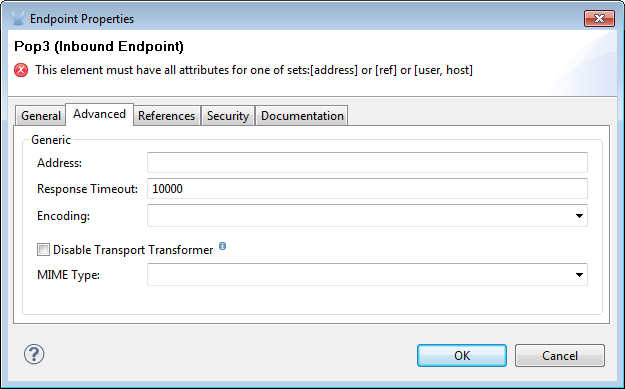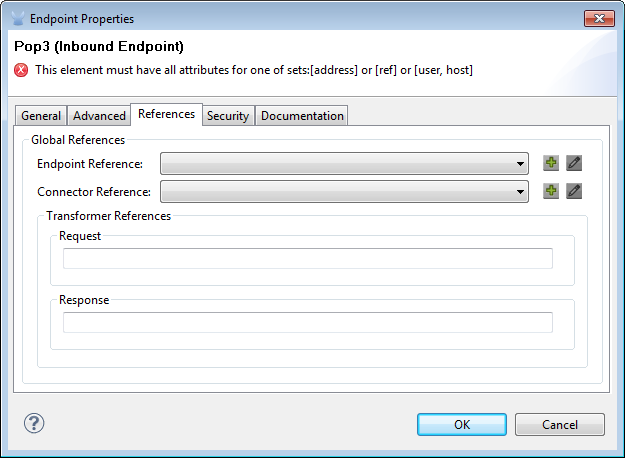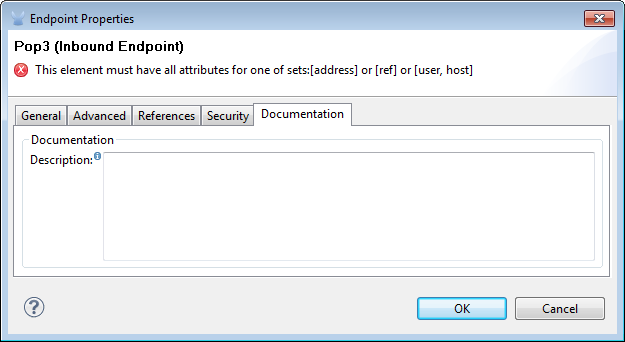
POP3 Endpoint Reference

Overview
The POP3 endpoint, which is configurable only as an inbound endpoint (i.e., message source) with a one-way exchange pattern, implements a transport channel that enables your Mule application to retrieve email from a POP3 email server.
POP3 is similar to IMAP, except IMAP supports both online and offline modes. For instance, IMAP users can leave email messages on the IMAP server until they explicitly delete them. Like IMAP, POP3 cannot send email; for that, you must implement an SMTP outbound endpoint.
For a secure transport channel (either TLS or SSL), you can specify the POP3S protocol.
Configuration
POP3 endpoint configuration consists of two stages:
-
Place your POP3 endpoint at the head of the sequence of building blocks that make up your Mule flow. Since it must serve as the message source for your flow, it cannot occupy any other position. (You can also use the Composite Source scope to wrap the POP3 endpoint along with the IMAP endpoint so that your flow can receive email through multiple transport channels).
-
Configure the POP3 endpoint by providing values for the fields on the various tabs on the Properties pane, which you open by double-clicking the POP3 endpoint icon on the Message Flow canvas.
The POP3 Endpoint Properties pane contains five tabs, as detailed below:
General Tab

| Property | Description |
|---|---|
Display Name |
Defaults to the generic endpoint name. Change the display name, which must be alpha-numeric, to reflect the endpoint’s specific role in the flow, i.e. |
Host |
Enter the Fully Qualified Domain Name (FQDN) or IP address of the POP3 server from which email will be retrieved. Defaults to localhost. |
Port |
The port number that connects to the POP3 server. For POP3, the default is 110; for POP3S, the default is 995. |
User |
The username for authentication on the server. |
Password |
The password for authentication on the server. |
Advanced Tab

| Property | Description |
|---|---|
Address |
Specify the URL of the POP3 server from which email is to be retrieved. |
Response Timeout |
Specify how long (in ms) the endpoint must wait for a response from the POP3 server. |
Encoding |
Choose from a drop-down list the character set used for message data. (i.e. UTF-8). |
Disable Transport Transformer |
Check this box if you do not want to use the endpoint’s default response transport. |
MIME Type |
Select from the dropdown list one of the formats this endpoint supports. |
References Tab

| Field | Description |
|---|---|
Endpoint Reference |
Use the drop-down list to select a previously configured global endpoint template, if any exist. If you have not created a global element for this type of endpoint, you do so by clicking Add and completing the fields on the pane that appears. Click Edit to modify a previously created global element. |
Connector Reference |
Use the dropdown list to select a previously configured connector template for this endpoint. If you have not created a connector for this type of endpoint, you can do so from this window by clicking Add. Click Edit to modify a previously created global element. |
Request Transformer References |
Enter a list of synchronous transformers that will be applied to the request before it is sent to the transport. |
Response Transformer References |
Enter a list of synchronous transformers that will be applied to the response before it is returned from the transport. |
Security

| Property | Description |
|---|---|
Enable Security |
Check this box to enable POP3S security for this endpoint. By default, POP3S is turned off. |
Documentation Tab
The Documentation tab lets you add optional notes to aid subsequent development and administration efforts.

| Property | Description |
|---|---|
Documentation |
Enter a detailed description of this POP3 endpoint for display in a yellow help balloon that pops up when you hover your mouse over the endpoint icon. |
Reference
See the POP3 Transport Reference for details on setting the properties for a POP3 endpoint using an XML editor.



